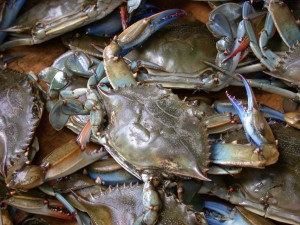This past week, the venerable Angus Phillips – former outdoors columnist for The Washington Post – emerged briefly from retirement to make an angry plea on The Post’s pages: ban crabbing in the Chesapeake Bay. He lamented this summer’s lousy blue crab numbers – foretold by this past winter’s dredge survey – and reminded readers of what it took to save striped bass (rockfish) back in the 1980’s. Namely, a complete moratorium on fishing for five years.

He’s not the only one crying “halt.” The Baltimore Sun’s Dan Rodricks called for a one year moratorium back in May, as soon as the states of Maryland and Virginia released the survey data. That survey showed that spawning-age female crabs in particular were below levels needed to sustain the population, and all crabs (including males and juveniles) were below 2008 levels. That’s the year that the states of Virginia and Maryland began working collectively with the Potomac River Fisheries Commission on new management measures to rebuild crab numbers. For a few years, it seemed to work. Crab numbers grew to an estimated 765 million in 2012, still short of the 828 million in 1991 but an improvement over previous lows. But then they plunged in 2013 and again this year to about 300 million.
That’s the thing about stocks like crabs and striped bass – they can fluctuate wildly from year to year. Sometimes uncontrollable environmental conditions contribute to booms or busts; scientists believe this winter’s polar vortexes killed off about a quarter of the Bay’s crabs. But as The Post’s Darryl Fears noted this spring, crashes often follow years of abundant harvest, suggesting that “harvest” too often becomes “overharvest.” In other words, fishing levels matter. Scientists generally agree that striped bass returned because of the fishing moratorium, and would have collapsed without it.
Moreover, many environmental conditions are within our control. Habitat loss caused by human activities undoubtedly contributes to blue crab declines. Excess sediment, fertilizer and other nutrients flowing off landscapes throughout the watershed smother seagrasses that juvenile crabs need for food and shelter. And although the striped bass recovery is impressive and encouraging, some scientists now worry that pollution and inadequate food supplies are making bass susceptible to the disease mycobacteriosis. Menhaden–an oily and historically abundant fish – has been a staple food for striped bass but is now at record lows (which many blame on overfishing). And high water temperatures combined with low levels of oxygen in the Bay’s summertime dead zones create additional stress for striped bass, potentially making them even more susceptible to disease.
Like most environmental problems, the crab crisis has no single solution. Perhaps fisheries managers ultimately will decide that, like striped bass, blue crabs need a break from fishing. But in the meantime, there are plenty of other ways to help protect habitat, reduce runoff, and restore aquatic life throughout the watershed. Check out what some of our partners are doing here, and learn how The Downstream Project can help.

